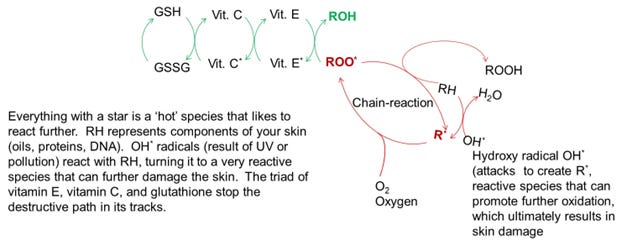On Vitamin E in skin care
Our inaugural post discussed the many benefits of vitamin C in skin health. This article will shine light on vitamin C’s trusted friend, vitamin E, as they go hand in hand to give your skin the care that it needs. Vitamin E is a collective name for a family of eight molecules, four tocopherols (α-, β-, ϒ-, and δ-), and tocotrienols (α-, β-, ϒ-, and δ-). It is fat-soluble (unlike the water-soluble vitamin C), found in vegetable oils, as well as nuts, like almonds, for example, and whole grains. Vitamin E deficiency is known to cause skin issues (usually in the form of lesions on skin). It should be a prominent nutrient in your diet, and it should be in your creams as well.
What does it actually do that’s so good? It has anti-inflammatory effect on the skin. Moreover, it can protect collagen because it can inactivate the so called metalloproteinases, a family of enzymes that can cross-link collagen, reducing its elasticity. In some studies, it has been shown to restore the telomere length, the shortening of which is a trademark of ageing. It can also increase the collagenase expression in skin, meaning it increases the production of enzymes that make collagen.
Vitamin E is not only good for your skin, but it is good for your cream, too, as it increases its shelf life. Your cream has botanical oils in it, and those are susceptible to air oxidation, which ultimately leads to rancidity, with a characteristic bad smell. Vitamin E intercepts that process, leading to longer shelf life. It’s also why it’s used in many packaged foods, as it prevents them from going rancid.
That same function is part of why it is good for your skin as well. Your skin, particularly its surface, is oil-rich. Vitamin E protects it from UV damage and pollution, by quenching the free radicals that attack it. Free fatty acids, especially polyunsaturated acids (omega3 and omega6) are very prone to oxidative attack by radical oxygen species (ROS). Vitamin E, being oil-soluble, prevents that process from spreading and doing further damage. In doing so, however, it does get oxidized itself, to its own radical species. And, precisely for that reason, the skin-protecting mechanism rests on more than just vitamin E.
In the previous article, we talked about vitamin C, and its role in healthy skin. Vitamin C also quenches free radicals, but it does so in a beautiful synergy with vitamin E and glutathione. When vitamin E gets oxidized (Vit E*), vitamin C is there to bring it to its reduced, active form. The vitamin C radical (Vit C*) is then reduced to vitamin C by glutathione, a peptide antioxidant present in all our cells. Vitamin C can then get to work again. As in a dance, the three work together, tossing electrons where they need to go, to keep your skin free of damage, to keep you healthy and beautiful.
So you see why it might be important to have enough of both vitamin C and E in your diet, as well as in your creams. By protecting your skin, they both get depleted, and should be replenished both through your nutrition and in the form of nourishing creams. It should be noted, though, that there is such a thing as ‘too much vitamin E’, particularly through diet. When consumed in excess, it acts as a blood thinner, and may lead to nausea, muscle weakness, and some other unwanted effects. The recommended amount is 12 mg/day, but tolerable upper limit is around 300 mg/day.
Now, back to creams and serums. Since they work together so well, it’s a good idea to apply vitamins C and E to your skin together, too. With addition of yet another antioxidant, however, the whole becomes much more than the sum of parts, exhibiting greater shelf stability and skin effectiveness. But that’s a story for another day.
Till next time,
Dr Lasio

